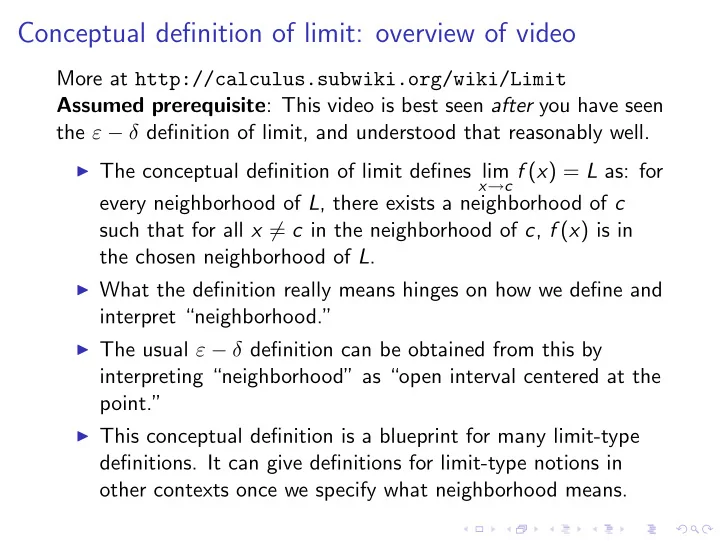

Conceptual definition of limit: overview of video More at http://calculus.subwiki.org/wiki/Limit Assumed prerequisite : This video is best seen after you have seen the ε − δ definition of limit, and understood that reasonably well. ◮ The conceptual definition of limit defines lim x → c f ( x ) = L as: for every neighborhood of L , there exists a neighborhood of c such that for all x � = c in the neighborhood of c , f ( x ) is in the chosen neighborhood of L . ◮ What the definition really means hinges on how we define and interpret “neighborhood.” ◮ The usual ε − δ definition can be obtained from this by interpreting “neighborhood” as “open interval centered at the point.” ◮ This conceptual definition is a blueprint for many limit-type definitions. It can give definitions for limit-type notions in other contexts once we specify what neighborhood means.
Conceptual definition of limit: checkpoint questions More at http://calculus.subwiki.org/wiki/Limit ◮ Assuming you are familiar with the idea of describing the ε − δ definition of limit in terms of a limit game: Can you interpret the conceptual definition of limit in terms of a generic limit game? ◮ Consider the setup of finite limits of functions of one real variable, i.e., lim x → c f ( x ) = L , with c and L real numbers. Suppose that, for our notion of neighborhood, we only required an open interval containing the point, rather than an open interval centered at the point. Would that change the meaning of limit?
Limits at and to infinity: overview of video More at http://calculus.subwiki.org/wiki/Limit Assumed prerequisite : This video is best seen after you have seen the ε − δ definition of limit and the conceptual definition of limit in terms of neighborhoods. ◮ There are nine limit-type notions once we allow the domain and range side variables to approach + ∞ (usually just written ∞ ) or −∞ . Specifically, the domain variable may be approaching a finite number, + ∞ , or −∞ . The function value may be approaching a finite number, + ∞ , or −∞ . The total number of cases is 3 × 3 = 9. ◮ We use the conceptual definition of limit to construct these definitions. The neighborhood concept for a finite point is an interval centered at that point. For + ∞ , it is an interval of the form ( a , ∞ ) , a ∈ R . For −∞ , it is an interval of the form ( −∞ , a ) , a ∈ R .
Limits at and to infinity: checkpoint questions More at http://calculus.subwiki.org/wiki/Limit ◮ Only three of the nine cases have been covered in the video. Try constructing definitions for the other cases. You can check your answers against the link above. Note that the choice of variable names for the parameters describing the neighborhoods is not fixed, but you must use different variable names for different parameters within a definition. ◮ You can also construct definitions for one-sided limits at a finite point to + ∞ or −∞ . There will be four definitions, based on whether the approach on the domain is from the left or the right and whether the limit is + ∞ or −∞ .
Limits at infinity – reals versus sequences: overview of video More at http://calculus.subwiki.org/wiki/Limit Assumed prerequisite : This video is best seen after you have seen the various definitions for limits at and to infinity for the reals. ◮ The definitions for the real-sense limit lim x →∞ f ( x ) and the sequence limit n →∞ , n ∈ N f ( n ) are almost the same. The key lim difference: the real-sense limit requires the function value to be trapped close to the claimed limit for all sufficiently large real numbers , whereas the sequence limit requires trapping close by only for all sufficiently large natural numbers . ◮ If the real-sense limit exists, the sequence limit exists and they are equal. If the real-sense limit is + ∞ , the sequence limit is + ∞ . If the real-sense limit is −∞ , the sequence limit is −∞ . ◮ It may happen that the real-sense limit does not exist but the sequence limit does exist. An example is f ( x ) := sin( π x ).
Limits at infinity – reals versus sequences: checkpoint questions More at http://calculus.subwiki.org/wiki/Limit ◮ Is it possible to have a function f defined on the reals such that lim x →∞ f ( x ) and n →∞ , n ∈ N f ( n ) both exist, but are different? lim ◮ Is it possible to have a function f defined on the reals such that n →∞ , n ∈ N f ( n ) = + ∞ but lim lim x →∞ f ( x ) does not exist either as a finite number or as + ∞ or −∞ ?
Recommend
More recommend